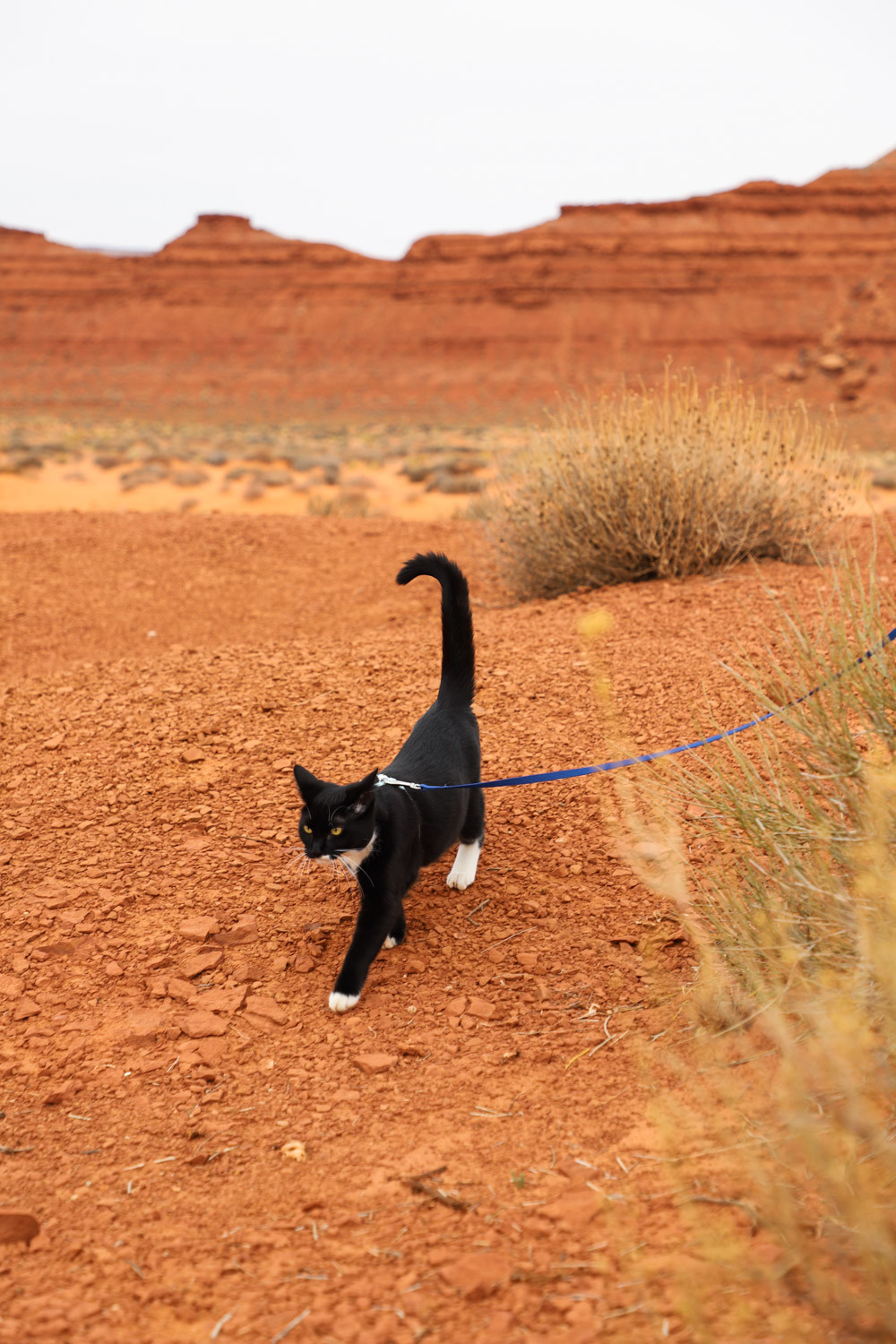Traveling with a cat might sound like a daunting task, often bringing to mind images of stressed felines and chaotic journeys. However, with the right approach and preparation, exploring the world with your feline friend can be a rewarding experience for both of you. Just like dogs, cats can be trained and many possess a curious nature that makes them surprisingly good travel companions. My own cat, Josie, has journeyed thousands of miles with me, experiencing diverse landscapes from red rock deserts to snow-covered mountains. While it requires extra planning, the joy of sharing adventures with her far outweighs the challenges.

Traveling with a cat offers a unique perspective, allowing you to slow down and appreciate the details you might otherwise miss. If you’re considering taking your cat on your travels, here’s what I’ve learned from my adventures with Josie to ensure smooth and enjoyable trips.
Understanding Your Cat’s Personality is Key
Before you even think about packing a suitcase, consider your cat’s personality. Not all cats are cut out for the travel life. Just like humans, cats have distinct personalities, and some are naturally more adaptable to new environments than others. Experts categorize cat personalities into different types, with some being better suited for outdoor activities and travel.
When I chose Josie, I looked for a kitten that was socialized, friendly, and moderately cautious. She’s a tuxedo cat, known for their lively, energetic, and easy-going nature – often described as being almost dog-like in their sociability and intelligence. This “puppy-cat” temperament made her a promising candidate for leash training and travel. Understanding your cat’s baseline temperament is the first step in determining if they might enjoy traveling. Observe their reactions to new situations at home – are they curious and adaptable, or anxious and withdrawn? This will give you valuable clues about how they might handle travel.
Start Slowly and Be Patient with Training

Leash training a cat and getting them comfortable with travel is not an overnight process. Patience is paramount. The first time you introduce a harness, your cat might react dramatically, flopping over or refusing to move. This is normal! The key is to take baby steps and use positive reinforcement.
Start by getting your cat accustomed to wearing a harness indoors for short periods, rewarding them with treats and praise. Gradually increase the duration and then introduce the leash. Once they are comfortable indoors, begin with short outdoor excursions in a safe, enclosed space like your backyard. Remember, cats aren’t dogs. They won’t naturally walk alongside you in the same way. Leash walking with a cat is more about allowing them to explore at their own pace while ensuring their safety. Don’t be discouraged by slow progress. Even older cats can be leash trained with patience and consistency. Josie started her training as a kitten, but adult cats can also adapt well with a patient owner.
Embrace the World at Your Cat’s Pace
Traveling with a cat requires a shift in perspective. You won’t be able to cover ground as quickly or stick rigidly to a schedule. However, this slower pace can be incredibly enriching. Cats experience the world through their senses in a very detailed way. Pay attention to what captures their interest – a particular scent, a rustling leaf, or a distant bird sound. Engage with their curiosity, and you might discover details of your surroundings you would have otherwise overlooked.
If your cat decides to stop and intensely sniff a bush, take a moment to consider what might have left its scent there. Is your cat chattering at something in a tree? Take the time to identify the bird that has caught their attention. Sometimes, your cat might move very slowly, or even stop altogether. In these moments, you might need to carry them for a bit, either in your arms or a cat backpack. The goal is to balance their exploration with making progress on your journey. Traveling with Josie has taught me to be more present and mindful. She reminds me to appreciate the small wonders of the world – the scents, textures, and subtle movements that often go unnoticed. It’s a more immersive and sensory way to experience travel.

Create a Secure and Familiar Space
Cats are creatures of habit and territory. When traveling, it’s essential to provide them with a safe and familiar space where they can retreat if they feel stressed or overwhelmed. This could be their carrier, a cat backpack, or even just your reassuring arms. Having a designated “safe zone” is a significant stress reliever, especially in unfamiliar environments or when encountering new stimuli like other animals or loud noises.
A familiar-smelling blanket or toy placed in their carrier can further enhance their sense of security. In your accommodation, designate a quiet corner as their space, complete with their bed, food, water, and litter box. This helps them adjust to the new environment and reduces anxiety.
Stay Calm and Positive: Your Mood Matters
Cats are incredibly sensitive to their owners’ emotions. If you are feeling stressed or anxious during your travels, your cat will likely pick up on it and become more stressed themselves. Conversely, your calm and confident demeanor can have a soothing effect on your feline companion.
If you notice your cat becoming agitated, take a moment to check in with your own emotional state. Take a deep breath, speak to your cat in a gentle, reassuring voice, and offer soft pets. Creating a calm and positive atmosphere will help your cat feel more secure and relaxed during travel.

Be a Responsible and Respectful Traveler
When traveling with a cat, it’s crucial to be a responsible and respectful pet owner. Always adhere to local rules and regulations regarding pets, whether you are in your neighborhood or visiting a national park. Keep your cat on a leash at all times, even in areas where dogs are allowed off-leash. This is for their safety and the consideration of others.
Choose pet-friendly accommodations and be mindful of other guests. While accidents are rare with trained cats, always be prepared to clean up after your pet and practice Leave No Trace principles. Regarding litter boxes, bring a portable litter box from home to maintain your cat’s routine and comfort. Travel litter boxes and eco-friendly options are available. Some owners even train their cats to use a toilet, but a familiar litter box is generally the easiest and least stressful option for travel.

Know When to Let Your Cat Stay Home
Finally, recognize that not every trip is suitable for your cat, and sometimes the kindest thing you can do is leave them in the care of a trusted friend, family member, or pet sitter. Certain modes of transport or destinations might be too stressful or unsafe for your cat. Never leave your cat unattended in a vehicle, especially in hot or cold weather.
It’s perfectly okay to plan trips that are just for you, knowing your cat will be safe and comfortable at home. Traveling with a cat is a wonderful experience, but it’s not always the best option. Prioritize your cat’s well-being and choose travel plans that suit both of your needs.

Traveling with a cat enriches your adventures, offering a unique perspective and strengthening your bond with your feline companion. With patience, understanding, and careful planning, you can unlock a new world of exploration together.
For more resources on training and traveling with cats, AdventureCats.org is an excellent online community.
What are your experiences traveling with your cat? Share your tips in the comments below!

